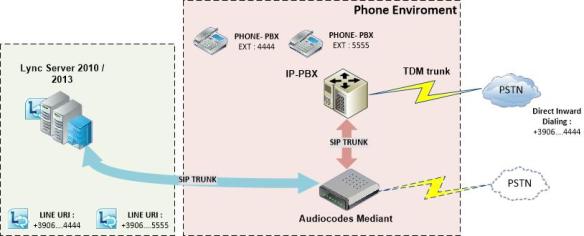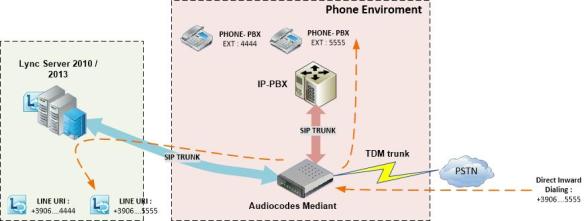As i mention in my last post (part 1) we can choose to use the Voice gateway in pass-through as shown here :
but to do this , we have to consider various steps before moving the IP-PBX in production and insert voice gateway between PSTN and the enviroment, so let start from the beginning, these are necessary steps :
1. Voice gateway configuration for PSTN trunk (only configuration not yet connected), in the other side (to lync and to PBX) configuration of SIP trunk to Lync and SIP trunk to IP-PBX (IMPORTANT : to obtain a dual forking of calls in this scenario we must use only sip trunk to and from PBX , so we must have an IP-PBX with sip trunk enabled ).
At this step we don’t have any disservice on IP-PBX production environment but we are ready to switch PSTN from IP-PBX to Voice gateway .
2. We can schedule session tests to verify that all configuration made before work fine (for example during time range in which we couldn’t have any outages to users, for example during the night?), in this way if not all scheduled tests list will be fine , we can rollback easily and move PSTN trunk to IP-PBX again.
To achieve this we must locate the Voice gateway properly sized, to mantain compliance on requirement in terms of business continuity, for example redundant power supply , right number of SIP channels to/from lync, and to/from IP-PBX.
In this way we can also test a SIP trunking from a provider instead of PSTN (or buy another PSTN trunk to do a test pilot for Lync voice for example) , because until we switch the PSTN from IP-PBX to Voice Gateway, we can work easily in Voice Gateways side without give any problem in IP-PBX side.
About call flow management and dual forking we have the same behavior as i wrote in my previous post (part 1) , unique difference is that all configuration for dual forking is made in Voice gateways side , and in PBX side we have only to switch all inbound and outbound call to the new SIP trunk instead of PSTN trunk already switched off.
At this point we can assert that we have a lot of way to do a soft migration or simply to use the existence telephony infrastructure for Lync and generally Microsoft UC. We know that Microsoft Lync just for presence/audio/video/conference is really wasted and with a good approach and a small effort we can implement an excellent Lync Voice project for a really Unified Communications experience.

Pingback: MS Unified Communications blog: PBX replacement with MS Lync (with Dual Forking) Part 2 « Lync News